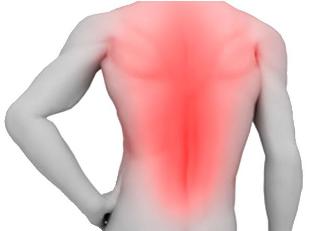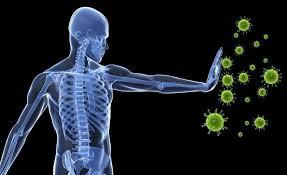If you have pain in the muscles of the back, the reasons can be different. The back of a man from the occiput to the sacrum is completely covered with muscles and is a very physical activity. So why hurt the back muscles?
Pain and crisis in the joints with the passage of time can lead to horrible consequences - local or full restriction of movement in the joint while the disability. People, taught by bitter experience to treat pain are a natural remedy which has been recommended by a rheumatologist.
Diseases of the spine
They suffer 85% of the population. Affect the vertebrae, intervertebral discs, spinal cord, stem, roots of the spinal nerves, veins, arteries, capillaries, ligaments, muscles. The most common diseases: osteochondrosis, spondylitis, ankylosing spondylitis, arthritis, arthrosis, scoliosis.
The enemy of the spine
Osteochondrosis is a chronic disease of the spine, leading to degenerative lesions and destruction of bone tissue, intervertebral discs, vertebral joint cartilage as a result of:
- hereditary predisposition;
- a wrong diet;
- excess weight;
- injuries;
- sedentary way of life;
- excessive loads;
- stress, etc.
Anatomical and morphological transformations of the spine, its pathology mobility shattered nerves, soft tissues, bone marrow roots and vessels.
Occurs pain.Symptoms:
- keeping the body;
- reduction of mobility of the vertebral joints (inability to straighten 100%, turn head);
- the reduction of skin sensitivity, numbness, prickling.
To ease the burden of the modified spine and the muscles reflexively tense up (compressed). Over time, the constant voltage causes a variety of aches and pains. The nature and localization of the pain They are influenced by the distribution area:
- In the case of cervical degenerative disc disease, when the compressed veins and arteries, the pain paroxysmal, burning, throbbing. Localization is often one sided – the back of the head, and the other part of the head.
- If thoracic degenerative disc disease, the symptoms of which often resembles other diseases (internal organs, for example), the pain is sharp in nature, similar to myocardial infarction, or gradual, incremental, similar to pneumonia, but the absence of cough and high temperature. Concentrate in the asks between costas area in the shoulder blade and the upper part of the abdomen.
- When lumbar osteochondrosis, muscle pain lumbar sudden, with backache. Pain in the muscles of the lumbar and leg, with the recoil in the groin and pelvis.
In the complicated version, with the intergrowth of the vertebrae, the pain decreases or disappears.
Additional symptoms
With cervical osteochondrosis, in addition to the fact that the pain in muscles and back and neck, with symptoms of hypoxia: dizziness, nausea, headache, loss of alertness, sensitivity of the hands and shoulders, shortness of breath, limitation of cervical mobility. In adulthood, it is possible sudden loss of consciousness, extreme version – paresis and paralysis of the hands.
If thoracic degenerative disc disease — cough, "a piece" in the throat, difficulty swallowing, bending, raising of the hands, hypertension, pain in the heart area.
While lumbar degenerative disc disease — numbness of the skin, paresis and paralysis of the legs, men – problems with urination and erections, in women – the menstrual cycle.
What doctor to address, diagnostics
Due to similar with other disease symptoms sick people go to the therapist, cardiologist, gastroenterologist. This takes time, causes complications. The relevant doctor is a neurologist.
2 methods of diagnosis:
- laboratory: General and biochemical blood tests;
- instrumental: x-ray of the spine in 2 projections, MRI, CT and biopsy by microscopy.
The results of this research are the selected options therapeutic techniques. Treatment of degenerative disc disease If there is pain in the muscles of the back pain, conservative and surgical treatment. Conservative in common:
- Drugs. Is assigned in times of crisis. Used Nsaids, muscle relaxants, hondoprotektory, vitamins b, E, angioprotectors, glucocorticoids, biogenic stimulators.
- Physiotherapy. With electrophoresis, acupuncture, magnetic therapy, physical therapy, etc. the healing process is faster.
- The spa treatment. Effectively in remission.
- Diet. During the crisis, have to eat small portions 5-7 times a day, eliminating fried, choice of boiled and steamed food. Drink at least 1.5 liters of water a day.
If inefficacia methods performs the operation: remove intervertebralis herniation or intervertebral disk replacement with a silicone implant (prosthesis).
Diseases of the internal organs
Sometimes the muscle pain occurs on the background of diseases of internal organs:
- The gastrointestinal tract (stomach ulcer and duodenal ulcer, perforated ulcer, intestinal pathology);
- the pancreas (chronic inflammation of the pancreas, chronic pancreatitis);
- gallbladder (acute cholecystitis);
- of the liver (colic);
- respiratory (pneumonia, pleurisy, bronchitis, tuberculosis);
- of the genitourinary system (prostatitis, renal colic), gynecological diseases (myomas, inflammation of uterine appendages, endometriosis);
- cardiovascular diseases (myocardial infarction, angina, ischemic heart disease, aortic aneurysm).
The type of pain, concentration
When violations of the gastrointestinal tract, pancreas, gall bladder and the liver acute pain localization – stomach, right side, with irradirovaniem in the lower part of the back and collar bone, a little below the shoulder blade. In hepatic colic the pain covers the right shoulder, shoulder blade, neck, stomach. When inflammation of the prostate around the pain.
In diseases of the gynecological and genitourinary apparatus muscles are pain in the lower back. Severe pain in the abdomen and genitals, diffundit in the rear on both sides, on the background of frequent urination, evidence of renal colic.
In diseases of the respiratory system on the background of the heat diffundit back pain below shoulder blades and chest, scelesto cough.
Pain in the back of the left hand, stretching the left arm and neck, evidence of pathologies of the cardiovascular system.
And symptoms associated with
Plagued by nausea, heartburn, vomiting, hyperhidrosis. The muscles of the stomach wall is compressed, making the abdomen hard.
Mechanical damage
Has the largest spread of the cause. You can get:
- athletes in training because of the wrong calculation of the gravity or weight;
- children with excessive mobility;
- divers when hitting the water.
- pregnant women;
- young mothers when raising the child;
- when lifting weights or increased physical loads;
- with intense movements;
- in the fall, especially of the height of the arms or landing on his feet, during which you can get a compression injury of the vertebrae;
- when the mechanical shock from the outside — blunt force, blast, etc.
Main symptoms: pain in the back muscles along the spine and place of injury, the swells up. Due to injury of the blood vessels is bleeding in the soft tissues, and bruises.
Kind of pain, localization
Damage due to injury of the spine lead to dull diffuse pain at the site of injury, without a clear definition of concentration. In injuries leading to torn ligaments without displacement or fracture of the spinous processes, the pain is sharp, focuses in the area of the spinous and the transverse processes of the fracture – in the region of the injured bone.
Additional symptoms
Damage in the thoracic region, loss of feeling in limbs, ataxia, pain in region of heart, during inspiration.
Who to contact, diagnosis
You have to get a meeting with the traumatologist, even if the damage seems insignificant. The effects of injury may appear later.
Is visual inspection, medical history, studying of the disease is assigned a CT scan, chest x-rays. For results diagnosis, further treatment lead neurosurgeon and semper. Recommended treatment With the minor damage shown bed rest, use of anti-inflammatory and analgesic ointments and gels. Bed rest gradually replace small loads, trying not to be restarted.
Of helminth infections, especially echinococcosis
Rarely cause. Echinococcosis is a parasitic diseasecaused by the larval stage of the tapeworm Echinococcus. The infection occurs:
- after contact with the animal carrier of worms;
- while eating contaminated animal faecal berries, vegetables, fruits;
- the water from the natural sources that contain helminth eggs.
Spread by the blood throughout the body, it affects the internal organs, the formation of one-part capsule, the cysts in the form of a bladder Cyst may contain up to 10 liters, to achieve a few pounds, to form one year. Overgrown cysts lead to progressive destruction of the affected organs, up to its atrophy. Cyst rupture can cause anaphylactic shock.
Cause pain in the muscles of the back often is hydatid disease of the spinal cord or kidneys.
The type of pain, location
The initial stage is asymptomatic. With the growth of cysts is changing.
When hydatid cyst of the spinal cord from the compression of the bladder body and the vertebral arch and the spinal cord, it seems, girdle sharp pain concentrated in the chest region, are increasing at a time of intense movements. The mobility of the spine is reduced, straight back muscles thicken, in the form of a roller, during the palpation of the spinous processes of the spine painful.
And symptoms associated with During the helminthiasis of the spinal cord feels pain in the limbs. When hydatid cyst of the kidney disease fatigue, lack of appetite, weight loss, malaise. At a later stage, added to renal colic, exacerbation of pyelonephritis, difficulty urinating, impaired mobility of the kidney, palpable tumor circular shape in the area of hypochondrium. Doctor Often people turn to allergists, internists, neurologists, infektsionistam that does not bring relief.
The treatment is a surgical intervention, the attending physician is a neurosurgeon.
Diagnostics of helminthiasis
The main methods are:
- CT. Can detect tumors in the spinal canal.
- Myelography. Introduced in the intercavernous channel of the spine, contrast agents allows you to take pictures (myelogram).
- A blood test . The reaction of passive hemagglutination.
Used for the treatment
So what should be done if the sore back muscles? Treatment of the spinal canal is the removal of the compressive vertebral arches (laminectomy), emptying of bladder, removal of the outer shell, the processing of the cavity is 2.5% iodium solution, then salt and sodium thiosulfate.
Cysts infected kidney to be removed, if necessary, resection, or nephrectomy. After surgical treatment, in order to avoid contamination are designated by antihistamines.
Autoimmune diseases
One of the most difficult reasons. Autoimmune myositis is an inflammation of striated muscle arising from the perception of the immune system on the cells of the muscle fibers for threatening the health of agents and the destruction of their connective membranes. Can be affected by one muscle (the local myositis) or more (priapism). If the affected skin, it is dermatomyositis. Autoimmune myositis is going on independently and on the background of the existing system pathologies: rheumatoid arthritis, lupus erythematosus, scleroderma.
The main symptoms are weakness of the muscles, tension and swelling of the muscles, pain in the muscles, restriction of movements of the diseased hard to get out of bed, serve yourself.

The type and location of pain
The pain is dull, not intense. Increases with the increasing of temperature, movements. In some cases, completely disappears. Are concentrated in the region of the affected muscles.
Accompanying symptoms
Perhaps the local increase of temperature. When pascebantur of the neck and the muscles, difficult swallowing, muscles of the thoracic and the diaphragm — a hard cough, the breathing.
In Dermatomyositis, the skin is edematous. Appear purple-red spots or nodules, severe itching. Who to contact, how to diagnose Autoimmune myositis can diagnose and treat a rheumatologist. Inspection of the patients, the clarification of existing complaints and the presence of systemic pathologies. Electromyography is indicated.
Treatment methodsTreatment contains the usage:
- steroid anti-inflammatory hormones;
- immunosuppressants that suppress the immune response;
- extracorporeal methods of treatment hemosorption, plasmapheresis;
- Nsaids.
During exacerbation of the disease intravenous vitamins and antitoxic solutions. After the relief of the condition usually prescribe medical massage and physical therapy.





































